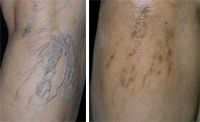- Case-Based Roundtable
- General Dermatology
- Eczema
- Chronic Hand Eczema
- Alopecia
- Aesthetics
- Vitiligo
- COVID-19
- Actinic Keratosis
- Precision Medicine and Biologics
- Rare Disease
- Wound Care
- Rosacea
- Psoriasis
- Psoriatic Arthritis
- Atopic Dermatitis
- Melasma
- NP and PA
- Skin Cancer
- Hidradenitis Suppurativa
- Drug Watch
- Pigmentary Disorders
- Acne
- Pediatric Dermatology
- Practice Management
- Prurigo Nodularis
- Buy-and-Bill
Article
Sclerotherapy: Appropriate patient expectations are crucial to overall treatment success
Sclerotherapy can produce excellent but highly variable results and requires good training, experience and a thorough discussion of risks, benefits and patient expectations, an expert says.

Key Points

"The reality is that sclerotherapy is an ablative therapy, so there are many variables involved, including tremendous individual variability. One person with veins of exactly the same size and in the same location may require a much higher or much lower concentration of sclerosants than another," says David M. Duffy, M.D., a Torrance, Calif., board-certified dermatologist with 30 years' experience in sclerotherapy.
Dr. Duffy holds teaching appointments at the University of California, Los Angeles, and the University of Southern California.

Other factors play a role, including obesity and hormones, which are associated with matting, as well as the ability of telangiectasia to become increasingly resistant with repeated treatments, possibly on the basis of impaired apoptosis, he says.
Patient consultation
In a typical consultation, Dr. Duffy says, "Patients will ask a lot of questions. The easiest way to address them is with handouts and a careful discussion."
Certain symptoms, such as aching, fatigue and swelling, coupled with a positive family history of varicose veins or the presence of large varicose veins or corona phlebectasia (clusters of spider veins around the ankles) suggest the need for a thorough workup, he says.
However, he says that many of his patients present with a few spider veins or reticular veins, which do not require the added time and expense.
When treating patients for veins of cosmetic importance only, he advises asking the patient which areas are most bothersome.
"If you don't treat these, the patient is going to be unhappy," Dr. Duffy says.
For many patients with telangiectasias, the anterior thighs or the areas of the lower legs, which are exposed when wearing a skirt, create the most concern, he says.
In these discussions, Dr. Duffy says, "I tell patients that outcomes can be quite variable; however, several patterns of response usually occur based on vessel size."
He emphasizes that the most common cause of dissatisfaction following telangiectasia treatments is matting, also called micro-telangiectasia, or second-generation telangiectasia, which is (at least transiently) often highly resistant to treatment.
In such cases, Dr. Duffy says, "It doesn't matter what technique you carry out. Patience, and infrequent treatments, are the best method."





